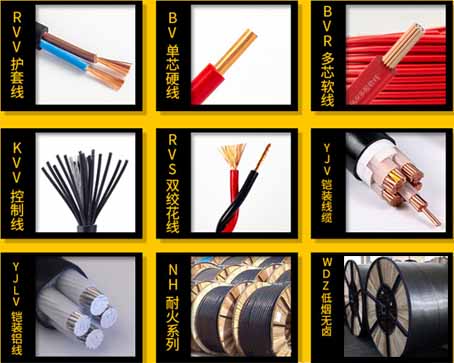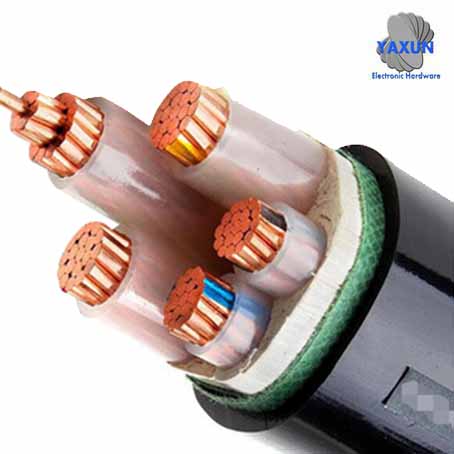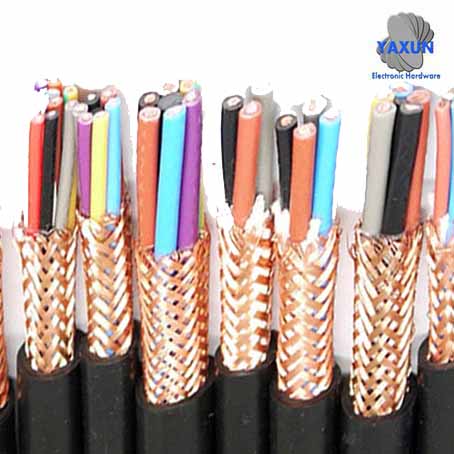Classification and Price of Flame Retardant Cables
The different cable flame retardant materials can be divided into: Halogen-containing flame-retardant cables and halogen-free low-smoke flame-retardant cables are two categories. The types of flame-retardant cables are: XLPE, BVR, WDZB-YJY, BV, nhbv, zr-bvr, YJV, ZA-BVR, WDZB-BJY, ZR-RVS, NG-A BTLY YTTW BBTRZ BTTZ, WDZ-BYJ, RVV, ZC -BVR, YJV, YJLV, WDZ, RVS, ZB-BVVR, ZC-YJV.

Halogen-containing flame-retardant cable insulation layer, outer sheath and auxiliary materials (tape and filling) are all or partly made of halogen-containing polyethylene (PVC) flame-retardant materials, so it has good flame-retardant properties. However, when the cable burns, a large amount of dense smoke and halogen acid gas will be released, and the halogen acid gas is corrosive to the surrounding electrical equipment. Rescuers need to wear gas masks to approach the scene to extinguish the fire. When the cable burns, it will cause harm to the surrounding electrical equipment and rescue personnel, which is not conducive to the fire fighting and rescue work, resulting in serious "secondary hazards".
Halogen-free low-smoke flame-retardant cable insulation, sheath, outer sheath and auxiliary materials (tape and filling) are all or partly made of halogen-free cross-linked polyethylene (XLPE) flame-retardant materials. Not only has better flame-retardant properties, but no halogen acid gas is released when the cable is burned, and the amount of smoke generated by the cable is also small. The corrosive gas generated by the burning of the cable is also between the flame retardancy of the cable and the reduction of the amount of halogen acid gas. A compromise method was adopted to develop low-halogen, low-smoke flame-retardant cables. Its halogen content is about 1/3 of that of halogen-containing flame-retardant cables. The amount of smoke is also close to the recognized "low smoke" level.
According to the "Wire and Cable Combustion Test Method", the flame-retardant cables assessed by the bundled combustion test method are classified into A, B, and C3 categories. Among them, Type A cables have the most demanding test conditions, have better performance than Type B and C, and are the most expensive. In order to achieve the flame retardant of the cable or improve the flame retardant level of the cable, people have developed the so-called "oxygen barrier" or "fire barrier". As a flame-retardant cable with a new structure such as filled or wrapped fire-proof and flame-retardant tape (fire-proof layer), this kind of cable is called "oxygen-proof (fire-proof) layer" cable. The main principle is that metal compounds are added to the material, which can also achieve low halogen and low smoke, halogen-free low smoke and flame retardant cables. However, the so-called "oxygen barrier" and "fire barrier" are just a means to achieve flame retardancy of cables. In the final analysis, it is still a flame-retardant cable, and the highest flame-retardant level it can achieve is also Class A. Therefore, the flame-retardant cable cannot be called the "oxygen barrier" cable, but the "oxygen barrier" cable can only be said to be a flame-retardant cable.

The flame retardancy of cables when multiple cables are densely arranged should be in accordance with the "Bundled Wire and Cable Burning Test Method" and the cable configuration. The principles of preventing catastrophic accidents and economic rationality are needed to meet the requirements of suitable categories. For the following places or circuits that need to be energized within a certain period of time due to the external fire, the exposed cables should be protected against fire or use cables with fire resistance. Important circuits such as fire protection, alarm, emergency lighting, breaker operation DC power supply, and power supply for emergency shutdown of generator sets and other important circuits; Computer monitoring, dual relay protection, security power supply, etc., one of the two circuits when the same channel is not isolated from each other when the two circuits are used together.
2. Fire-resistant protection of cables
When the number of cables is small, fire-resistant paint or tape can be applied to the cables, or the cables can be put through fire-resistant pipes. When there are many cables in the same channel, they should be laid in the fire-resistant trough box, and the power cable should be in a vented type. The semi-closed type can be used in a non-combustible dust environment. When the protective section of the cable laid on the bridge is not long, a fire-resisting package can also be used.
In oil tank farms, important public buildings with wooden structures, high-temperature places and other situations with high requirements for fire resistance, installation and economic performance, non-combustible mineral insulated cables can be used. If self-contained oil-filled cables are laid in public corridors, passenger tunnels, bridges, etc. where fire protection is required, they can be laid in sand. Cable trenches close to oil-containing equipment such as high-voltage current and voltage transformers are sealed with trench covers.
3. Dense places
In cable-intensive places or enclosed passages with high safety requirements, automatic fire detection and alarm devices suitable for reliable environmental actions should be equipped. The fuel supply system where the oil-filled cable is laid out shall be equipped with automatic fire alarm and lockout devices that can reflect the fuel injection status. The cable-intensive parts of underground public facilities, the terminal installation of multiple oil-filled cables and other places with higher safety requirements, can be installed with special fire-fighting facilities such as water spray fire extinguishing.

(1) Since the halogen-containing flame-retardant cable will release corrosive halogen acid gas when it is burned, it will greatly hinder the fire fighting work, which will delay the fire fighting time and increase the spread of the fire. Therefore, in public places with high population density, halogen-free, low-smoke flame-retardant cables should be designed as far as possible. Any kind of flame-retardant cable can be used in work areas with low population density.
(2) Flame-retardant cables are divided into categories A, B and C3, of which category A flame-retardant cables have better performance than category B and C, and the price is the most expensive. The designer shall indicate the type of flame-retardant cable when providing the order list.
(3) The A, B, and C categories of flame-retardant cables cannot be distinguished from the appearance. Only rely on the manufacturer to guarantee the supply, so the cable manufacturer should be carefully selected when designing and selecting.
(4) Compared with halogen-free and low-smoke flame-retardant cable, it has the advantages of low corrosion and low smoke, but the electrical and mechanical properties are significantly reduced. Therefore, when laying cables, halogen-free low-smoke flame-retardant cables should have a larger bending radius than halogen-containing flame-retardant cables.
(5) When designing cable laying, it is not advisable to lay non-flame-retardant cables and flame-retardant cables side by side. It is not advisable to lay flame-retardant cables of different flame-retardant categories side by side.
The main technical indicators related to the fire safety of the cable are the flame retardancy of the CO2 cable, the density of the smoke and the toxicity of the gas. The US fire protection standards pay more attention to the first two issues, but Europe and the US have completely different views on fire safety.
The American traditional concept thinks: The root of the fire lies in the production of carbon monoxide (CO) poisonous gas and the release of heat from the conversion of CO to CO2 in the subsequent combustion process. Therefore, controlling the amount of heat released during the combustion process can reduce the risk of fire.
The European tradition has been convinced that: The amount of halogen acid (HCL) released during combustion, gas corrosivity, smoke concentration and gas toxicity are the main factors that determine whether people can safely escape from the fire scene.
In order to evaluate the flame-retardant performance of cables, the International Electrotechnical Commission has formulated three standards: IEC60332-1, IEC60332-2 and IEC60332-3. IEC60332-1 and IEC60332-2 are used to evaluate the flame retardant ability of a single cable when placed in an inclined and vertical position (corresponding to GB12666.3 and GB12666.4 standards in China). IEC60332-3 (corresponding to GB12666.5-90 in China) is used to assess the flame retardancy of bundled cables when they burn vertically. In contrast, the flame retardant requirements of bundled cables are much higher when they burn vertically.
IEC60332-1/BS4066-1 flame retardant rating (single wire or cable vertical burning test)

Halogen-containing flame-retardant cable insulation layer, outer sheath and auxiliary materials (tape and filling) are all or partly made of halogen-containing polyethylene (PVC) flame-retardant materials, so it has good flame-retardant properties. However, when the cable burns, a large amount of dense smoke and halogen acid gas will be released, and the halogen acid gas is corrosive to the surrounding electrical equipment. Rescuers need to wear gas masks to approach the scene to extinguish the fire. When the cable burns, it will cause harm to the surrounding electrical equipment and rescue personnel, which is not conducive to the fire fighting and rescue work, resulting in serious "secondary hazards".
Halogen-free low-smoke flame-retardant cable insulation, sheath, outer sheath and auxiliary materials (tape and filling) are all or partly made of halogen-free cross-linked polyethylene (XLPE) flame-retardant materials. Not only has better flame-retardant properties, but no halogen acid gas is released when the cable is burned, and the amount of smoke generated by the cable is also small. The corrosive gas generated by the burning of the cable is also between the flame retardancy of the cable and the reduction of the amount of halogen acid gas. A compromise method was adopted to develop low-halogen, low-smoke flame-retardant cables. Its halogen content is about 1/3 of that of halogen-containing flame-retardant cables. The amount of smoke is also close to the recognized "low smoke" level.
According to the "Wire and Cable Combustion Test Method", the flame-retardant cables assessed by the bundled combustion test method are classified into A, B, and C3 categories. Among them, Type A cables have the most demanding test conditions, have better performance than Type B and C, and are the most expensive. In order to achieve the flame retardant of the cable or improve the flame retardant level of the cable, people have developed the so-called "oxygen barrier" or "fire barrier". As a flame-retardant cable with a new structure such as filled or wrapped fire-proof and flame-retardant tape (fire-proof layer), this kind of cable is called "oxygen-proof (fire-proof) layer" cable. The main principle is that metal compounds are added to the material, which can also achieve low halogen and low smoke, halogen-free low smoke and flame retardant cables. However, the so-called "oxygen barrier" and "fire barrier" are just a means to achieve flame retardancy of cables. In the final analysis, it is still a flame-retardant cable, and the highest flame-retardant level it can achieve is also Class A. Therefore, the flame-retardant cable cannot be called the "oxygen barrier" cable, but the "oxygen barrier" cable can only be said to be a flame-retardant cable.

Use of flame-retardant cables
1. Dense cablesThe flame retardancy of cables when multiple cables are densely arranged should be in accordance with the "Bundled Wire and Cable Burning Test Method" and the cable configuration. The principles of preventing catastrophic accidents and economic rationality are needed to meet the requirements of suitable categories. For the following places or circuits that need to be energized within a certain period of time due to the external fire, the exposed cables should be protected against fire or use cables with fire resistance. Important circuits such as fire protection, alarm, emergency lighting, breaker operation DC power supply, and power supply for emergency shutdown of generator sets and other important circuits; Computer monitoring, dual relay protection, security power supply, etc., one of the two circuits when the same channel is not isolated from each other when the two circuits are used together.
2. Fire-resistant protection of cables
When the number of cables is small, fire-resistant paint or tape can be applied to the cables, or the cables can be put through fire-resistant pipes. When there are many cables in the same channel, they should be laid in the fire-resistant trough box, and the power cable should be in a vented type. The semi-closed type can be used in a non-combustible dust environment. When the protective section of the cable laid on the bridge is not long, a fire-resisting package can also be used.
In oil tank farms, important public buildings with wooden structures, high-temperature places and other situations with high requirements for fire resistance, installation and economic performance, non-combustible mineral insulated cables can be used. If self-contained oil-filled cables are laid in public corridors, passenger tunnels, bridges, etc. where fire protection is required, they can be laid in sand. Cable trenches close to oil-containing equipment such as high-voltage current and voltage transformers are sealed with trench covers.
3. Dense places
In cable-intensive places or enclosed passages with high safety requirements, automatic fire detection and alarm devices suitable for reliable environmental actions should be equipped. The fuel supply system where the oil-filled cable is laid out shall be equipped with automatic fire alarm and lockout devices that can reflect the fuel injection status. The cable-intensive parts of underground public facilities, the terminal installation of multiple oil-filled cables and other places with higher safety requirements, can be installed with special fire-fighting facilities such as water spray fire extinguishing.

Precautions for flame-retardant cables
The designer should design, select and lay the cable according to the specific characteristics of the flame-retardant cable, and pay attention to the following issues:(1) Since the halogen-containing flame-retardant cable will release corrosive halogen acid gas when it is burned, it will greatly hinder the fire fighting work, which will delay the fire fighting time and increase the spread of the fire. Therefore, in public places with high population density, halogen-free, low-smoke flame-retardant cables should be designed as far as possible. Any kind of flame-retardant cable can be used in work areas with low population density.
(2) Flame-retardant cables are divided into categories A, B and C3, of which category A flame-retardant cables have better performance than category B and C, and the price is the most expensive. The designer shall indicate the type of flame-retardant cable when providing the order list.
(3) The A, B, and C categories of flame-retardant cables cannot be distinguished from the appearance. Only rely on the manufacturer to guarantee the supply, so the cable manufacturer should be carefully selected when designing and selecting.
(4) Compared with halogen-free and low-smoke flame-retardant cable, it has the advantages of low corrosion and low smoke, but the electrical and mechanical properties are significantly reduced. Therefore, when laying cables, halogen-free low-smoke flame-retardant cables should have a larger bending radius than halogen-containing flame-retardant cables.
(5) When designing cable laying, it is not advisable to lay non-flame-retardant cables and flame-retardant cables side by side. It is not advisable to lay flame-retardant cables of different flame-retardant categories side by side.
Standard for flame-retardant cables
The main technical indicators related to the fire safety of the cable are the flame retardancy of the CO2 cable, the density of the smoke and the toxicity of the gas. The US fire protection standards pay more attention to the first two issues, but Europe and the US have completely different views on fire safety.The American traditional concept thinks: The root of the fire lies in the production of carbon monoxide (CO) poisonous gas and the release of heat from the conversion of CO to CO2 in the subsequent combustion process. Therefore, controlling the amount of heat released during the combustion process can reduce the risk of fire.
The European tradition has been convinced that: The amount of halogen acid (HCL) released during combustion, gas corrosivity, smoke concentration and gas toxicity are the main factors that determine whether people can safely escape from the fire scene.
In order to evaluate the flame-retardant performance of cables, the International Electrotechnical Commission has formulated three standards: IEC60332-1, IEC60332-2 and IEC60332-3. IEC60332-1 and IEC60332-2 are used to evaluate the flame retardant ability of a single cable when placed in an inclined and vertical position (corresponding to GB12666.3 and GB12666.4 standards in China). IEC60332-3 (corresponding to GB12666.5-90 in China) is used to assess the flame retardancy of bundled cables when they burn vertically. In contrast, the flame retardant requirements of bundled cables are much higher when they burn vertically.
IEC60332-1/BS4066-1 flame retardant rating (single wire or cable vertical burning test)





